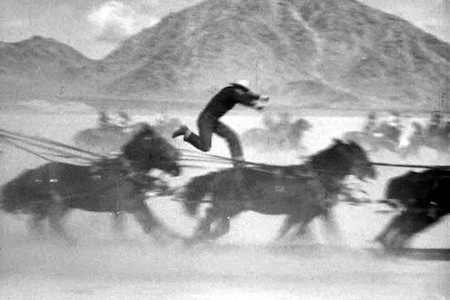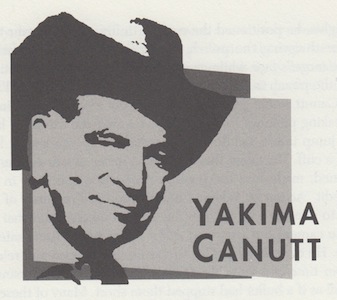Born: November 29, 1895, Colfax, WA
Died: May 24, 1986, Hollywood, CA
Yakima Canutt, the first and perhaps the best of the great stuntmen, transformed a suicidal gamble into a modern profession.
—Charlton Heston
Stuntmen who journeyed to Hollywood in the 1920s most likely found work in the breakneck comedies of Mack Sennett or the cowboy vehicles of Tom Mix. Mix was a perfectionist who swore that audiences could tell a real cowboy from a fake, so he recruited heavily from rodeos and ranches. In 1917, Mix met a trick rider named Eddie Canutt, who was often billed as “the Man from Yakima.”
Yakima Canutt, or “Yak,” followed Mix to Hollywood, where over the next fifteen years he worked steadily as a cowboy actor and stuntman. Specializing in horse falls and wagon wrecks, Canutt built a solid reputation as a man who would come on in the final scene of a western and leap from the hero’s horse to tackle a villain on the run. He was frequently used as a second-unit director on action westerns, also serving as stunt double for every actor in the production, even the women. During this active period, Canutt claimed he had broken every bone in his body.
In 1920, he met an unknown actor named John Wayne. From Yak Canutt, Wayne learned the nuances of a real cowboy, how to handle a horse and take a punch. In fact, the Duke was on the scene when Yak made one of his great contributions to movies—the art of the screen punch. To add to the realism, of movie fights, he positioned the camera to film an actor over the shoulder of the actor throwing the punch, so his fist could pass several inches in front of the target’s face while giving the illusion of a direct hit. The choreography of the punch in fight scenes is, of course, a staple of all action films.
Yakima Canutt would go on to be a stunt double for Wayne in a variety of roles, but taking punches for John Wayne wasn’t the extent of his portfolio. He would jump into a saddle from a second-story window or lead a horse straight off a cliff. His talent for executing a series of hair-raising stunts, precisely planned, made him the popular production specialist in Hollywood, and the credit “Action by Yakima Canutt” appeared on many of his films.
Seeking to minimize his injuries, he devised mechanisms that went unnoticed by the camera but triggered actions that made stunts safer and more predictable. He cleverly rigged his stirrups to break open and release his foot at the proper time and his cable rigs became the standard means of training horses to fall as if a bullet had stopped them short. Many of these tricks were adapted from rodeo; their unconventional methods were initially controversial, but Canutt invited Humane Society inspectors to judge his work and documented safety rules for other productions using animals.
After hundreds of silent horse operas, the physical demands caught up with the aging performer. Yak made a clever transition from stunt double to coordinator and reserved his body for special occasions only. One was Gone with the Wind (1939). He stood in for Clark Gable, navigating a horse-drawn wagon around the falling buildings of Atlanta as it burned; in another memorable scene, he took a bullet in the face from Scarlett O’Hara, then tumbled backward down a flight of steps. He was forty-four years old at the time.
Another special case was John Ford’s Stagecoach (1939). Canutt was hired to supervise the stunts, but when the time came for the dangerous work, he stepped in as both cowboy and Indian—even portraying a woman. The climactic scene, involving a runaway stage, required Yak to leap to a coach railing to the team of horses before drawing the stage to a halt. Well into his sixties, the cowboy star worked on the epic chariot race in Cecil B. DeMille’s Ben-Hur (1959) and contributed to Spartacus (1960) and El Cid (1961). His work in later years included stunts with motorcycles and automobiles, and his choreography of a spectacular car chase in The Flim-Flam Man (1967) is widely regarded as the all-time best example of high-speed thrills.
Yakima Canutt made hundreds of films in his prolific career, and some of his finest are still available on video, including Wild Horse Canyon (1925), The Devil Horse (1926) and The Iron Rider (1927). He was awarded the only special Oscar presented for stunt work, in 1966, for making it not only more artistic by also safer. He lived to the age of ninety, remained active in films until 1976 and helped establish his son in the same profession.
Every day, hundreds of stunt performers are acutely aware of his influence. He made his biggest impact on the profession through the vast number of safety guidelines he conceived and documented. By generously passing on a legacy of knowledge and skill, he elevated the stunt profession to become a vital part of the artistry of film.
To read all the republished articles from ‘The Film 100,’ go to Reintroducing the Film 100 here on Keyframe.





